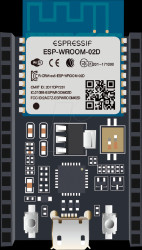ESP8266-DEVKITC-02D-F DEVELOPMENT BOARD ESP-WROOM-02D.
reichelt elektronik
 RSS
11.84 EUR50.51 PLN
RSS
11.84 EUR50.51 PLN
- Sklep zagraniczny
- MPN:
- ESP8266-DEVKITC-02D-F
- Kod:
- 311743
- Producent:
- ESPRESSIF SYSTEMS
- GTIN-13:
- 9900003117433
- Waluta:
- euro
- Dodany do bazy:
- Ostatnio widziany:
- Zmiana ceny:
- +6% (04.05.2025)
- Poprzednia cena:
- 11.16 EUR
Sugerowane produkty dla espwroom
ESP8266-DevKitC is a compact Espresso development board based on ESP8266 modules. All I/O pins on the module are split between the socket strips on both sides of the board for easy connection. Developers can connect these pins to peripherals as needed.
ESP-WROOM-02D with 2 MB flash
ESP-WROOM-02D/ESP-WROOM-02U SPECIFICATIONS: • RF CERTIFICATION: SRRC, FCC, CE (RED), IC, NCC, KCC, TELEC (MIC) • Green certification: RoHS, REACH • Wi-Fi protocols: 802.11 b/g/n. • Frequency range: 2.4 GHz ~ 2.5 GHz (2400 MHz ~ 2483.5 MHz) • Peripheral interface: UART/HSPI/I2C/I2S/IR remote control, GPIO/PWM • Operating voltage: 2.7 V ~ 3.6 V. • Operating current: Average: 80 mA • Minimum current supplied by the power supply: 500 mA • Operating temperature range: -40°C ~ 85°C. • Wi-Fi mode: Station/SoftAP/SoftAP + Station • Security: WPA/WPA2 • ENCRYPTION: WEP/TKIP/AES • Firmware upgrade: UART download/OTA (over network)/download and write firmware via host • Software development: Supports cloud server development/SDK for own firmware development • Network protocols: IPv4, TCP/UDP/HTTP/FTP • User configuration: AT command set, cloud server, Android/iOS app
Description: 1. CPU The ESP8266EX integrates a Tensilica L106 32-bit RISC processor that achieves extremely low power consumption and has a maximum clock frequency of 160 MHz. The Real-Time Operating System (RTOS) and Wi-Fi stack allow 80% of the computing power to be used for programming and developing user applications. The CPU has the following interfaces: • Programmable RAM/ROM (iBus) interfaces that connect to the memory controller and can also be used to read flash. • Data RAM (dBus) interface that can be connected to the memory controller. • AHB interface that can be used to visit the registry.
2. Memory 2.1 Internal SRAM and ROM ESP8266EX Wi-Fi SoC integrates the storage controller and storage units including ROM and SRAM. The MCU can access the storage units via iBus, dBus, and AHB interfaces. All storage units can be accessed on request. A storage arbiter determines the run order in the arrival order of the requests. According to our current version of the SDK, the available SRAM space is allocated as follows: • RAM size • There is no programmable ROM in the ESP8266EX, so the user program must be stored in an external SPI flash. 2.2 SPI Flash ESP8266EX supports SPI flash. Theoretically, ESP8266EX can support up to 16 MB of SPI flash. ESP-WROOM-02D and ESP-WROOM-02U currently integrate a 2/4-MB SPI flash. ESPWROOM-02U supports these SPI modes: Standard SPI, DIO (Dual I/O), DOUT (Dual Output), QIO (Quad I/O), and QOUT (Quad Output).
3. Quartz oscillator ESP-WROOM-02U and ESP-WROOM-02D use a 26 MHz crystal oscillator. The accuracy of the crystal oscillator should be ±10 PPM. If you are using the download tool, please select the correct type of crystal oscillator. In the circuit design, capacitors C1 and C2 are added to the input and output terminals of the crystal oscillator, each connected to the ground. The values of the two capacitors can be flexible and range from 6 pF to 22 pF. However, the specific capacitance values depend on further testing and adaptation to the overall performance of the entire circuit. Normally, the capacitive values of C1 and C2 are within 10 pF for the 26 MHz crystal oscillator.
Elecena nie prowadzi sprzedaży elementów elektronicznych, ani w niej nie pośredniczy.
Produkt pochodzi z oferty sklepu reichelt elektronik